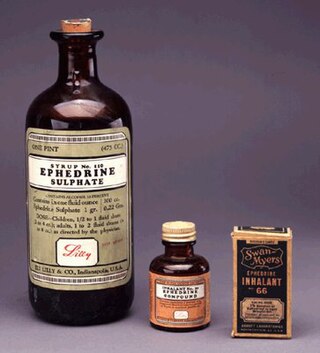
Pseudoephedrine (PSE) is a sympathomimetic drug of the phenethylamine and amphetamine chemical classes. It may be used as a nasal/sinus decongestant, as a stimulant, or as a wakefulness-promoting agent in higher doses.

Ephedrine is a central nervous system (CNS) stimulant that is often used to prevent low blood pressure during anesthesia. It has also been used for asthma, narcolepsy, and obesity but is not the preferred treatment. It is of unclear benefit in nasal congestion. It can be taken by mouth or by injection into a muscle, vein, or just under the skin. Onset with intravenous use is fast, while injection into a muscle can take 20 minutes, and by mouth can take an hour for effect. When given by injection it lasts about an hour and when taken by mouth it can last up to four hours.

Ephedra is a medicinal preparation from the plant Ephedra sinica. Several additional species belonging to the genus Ephedra have traditionally been used for a variety of medicinal purposes, and are a possible candidate for the soma plant of Indo-Iranian religion. It has been used in traditional Chinese medicine, in which it is referred to as Ma Huang, for more than 2,000 years. Native Americans and Mormon pioneers drank a tea brewed from other Ephedra species, called "Mormon tea" and "Indian tea".

Methcathinone is a monoamine alkaloid and psychoactive stimulant, a substituted cathinone. It is used as a recreational drug due to its potent stimulant and euphoric effects and is considered to be addictive, with both physical and psychological withdrawal occurring if its use is discontinued after prolonged or high-dosage administration. It is usually snorted, but can be smoked, injected, or taken orally.

D-norpseudoephedrine, also known as cathine and (+)-norpseudoephedrine, is a psychoactive drug of the phenethylamine and amphetamine chemical classes which acts as a stimulant. Along with cathinone, it is found naturally in Catha edulis (khat), and contributes to its overall effects. It has approximately 7-10% the potency of amphetamine.

Phenylpropanolamine (PPA) is a sympathomimetic agent which is used as a decongestant and appetite suppressant. It was commonly used in prescription and over-the-counter cough and cold preparations. In veterinary medicine, it is used to control urinary incontinence in dogs.

Guaifenesin, also known as glyceryl guaiacolate, is an expectorant medication that aids in the elimination of sputum from the respiratory tract. Chemically it is an ether of guaiacol and glycerine. It is often used in combination with other medications. It is taken by mouth.

Promethazine, sold under the brand name Phenergan among others, is a first-generation antihistamine, antipsychotic, sedative, and antiemetic used to treat allergies, insomnia, and nausea. It may also help with some symptoms associated with the common cold and may also be used for sedating people who are agitated or anxious, an effect that has led to some recreational use. Promethazine is taken by mouth, as a rectal suppository, or by injection into a muscle.
The ECA stack is a drug combination used in weight loss and as a stimulant. ECA is an initialism for ephedrine, caffeine, and aspirin, with variants of it including the EC stack, which removes the aspirin for those who can not tolerate it. Dietary supplements based on or including elements of ECA were popular through the 1990s and early 2000s, but the marketing of ephedra- or ephedrine-containing stimulant combinations for weight loss and bodybuilding is now restricted or illegal in the United States, Canada and Netherlands due to reports of heart attack, stroke, and death associated with these supplements.

Ethylmorphine is an opioid analgesic and antitussive.

The Misuse of Drugs Act 1973 is a drug control law in Singapore classifying substances into three categories, Classes A, B, and C. Section 44 provides that "The Minister may, by an order published in the Gazette" add, remove, or transfer drugs among the classes. The statute's penal provisions are severe by most nations' standards, providing for long terms of imprisonment, caning, and capital punishment. The law creates a presumption of trafficking for certain threshold amounts, e.g. 30 grams of cannabis. It also creates a presumption that a person possesses drugs if he possesses the keys to a premises containing the drugs, and that "Any person found in or escaping from any place or premises which is proved or presumed to be used for the purpose of smoking or administering a controlled drug shall, until the contrary is proved, be presumed to have been smoking or administering a controlled drug in that place or premises." Thus, one runs the risk of arrest for drug use by simply being in the company of drug users. The law also allows officers to search premises and individuals, without a search warrant, if he "reasonably suspects that there is to be found a controlled drug or article liable to seizure". Moreover, Section 31 allows officers to demand urinalysis of suspected drug offenders while section 8A prohibits any citizen or permanent resident of Singapore to use any prohibited drug outside of the country, and if found guilty to be punished as if they committed that act within the country.
Mamta Kulkarni is a former Indian actress and model known for her work in Hindi cinema. She has appeared in commercial successful Hindi films such as Aashiq Awara (1993), Waqt Hamara Hai (1993), Krantiveer (1994), Karan Arjun (1995), Sabse Bada Khiladi (1995), Andolan (1995), Baazi (1996), China Gate (1998) and Chhupa Rustam: A Musical Thriller (2001). Her performance in Aashiq Awara (1993) won her the 1994 Filmfare Award for Lux New Face of the Year. In the blockbuster Karan Arjun (1995), directed by Rakesh Roshan, Kulkarni starred alongside Salman Khan. She quit the film industry after her appearance in the film Kabhie Tum Kabhie Hum.
The athletics competition at the 2003 Pan American Games was held in Santo Domingo, Dominican Republic, from Tuesday, August 5, to Saturday, August 9, 2003. The competition comprised track and field events plus marathon races and three racewalking events, with a total of 46 contests taking place.

Benzylmorphine (Peronine) is a semi-synthetic opioid narcotic introduced to the international market in 1896 and that of the United States very shortly thereafter. It is much like codeine, containing a benzyl group attached to the morphine molecule just as the methyl group creates codeine and the ethyl group creates ethylmorphine or dionine. It is about 90% as strong as codeine by weight.
The illegal drug trade in China is influenced by factors such as history, location, size, population, and current economic conditions. China has one-fifth of the world's population and a large and expanding economy. China's large land mass, close proximity to the Golden Triangle, Golden Crescent, and numerous coastal cities with large and modern port facilities make it an attractive transit center for drug traffickers. Opium has played an important role in the country's history since before the First and Second Opium Wars in the mid-19th century.

A norepinephrine releasing agent (NRA), also known as an adrenergic releasing agent, is a catecholaminergic type of drug that induces the release of norepinephrine (noradrenaline) and epinephrine (adrenaline) from the pre-synaptic neuron into the synapse. This in turn leads to increased extracellular concentrations of norepinephrine and epinephrine therefore an increase in adrenergic neurotransmission.
Substituted amphetamines are a class of compounds based upon the amphetamine structure; it includes all derivative compounds which are formed by replacing, or substituting, one or more hydrogen atoms in the amphetamine core structure with substituents. The compounds in this class span a variety of pharmacological subclasses, including stimulants, empathogens, and hallucinogens, among others. Examples of substituted amphetamines are amphetamine (itself), methamphetamine, ephedrine, cathinone, phentermine, mephentermine, bupropion, methoxyphenamine, selegiline, amfepramone (diethylpropion), pyrovalerone, MDMA (ecstasy), and DOM (STP).

L-Norpseudoephedrine, or (−)-norpseudoephedrine, is a psychostimulant drug of the amphetamine family. It is one of the four optical isomers of phenylpropanolamine, the other three being cathine ((+)-norpseudoephedrine), (−)-norephedrine, and (+)-norephedrine; as well as one of the two enantiomers of norpseudoephedrine (the other being cathine). Similarly to cathine, L-norpseudoephedrine acts as a releasing agent of norepinephrine (EC50 = 30 nM) and to a lesser extent of dopamine (EC50 = 294 nM). Due to the 10-fold difference in its potency for inducing the release of the two neurotransmitters however, L-norpseudoephedrine could be called a modestly selective or preferential norepinephrine releasing agent, similarly to related compounds like ephedrine and pseudoephedrine.
European law on illicit drug precursors:

Cinnamedrine, also known as N-cinnamylephedrine, is a sympathomimetic drug with similar effects relative to those of ephedrine. It also has some local anesthetic activity. Cinnamedrine was previously used, in combination with analgesics, as an antispasmodic to treat dysmenorrhea in the over-the-counter drug Midol in the 1980s. There is a case report of the drug being abused as a psychostimulant.













